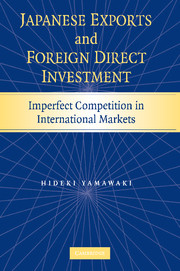Book contents
- Frontmatter
- Contents
- Tables
- Figures
- Preface
- 1 Introduction
- 2 Export Pricing Under Imperfect Competition
- 3 Export Price, Learning, and Domestic Demand Disturbances
- 4 Foreign Market Structure, Export Price, and Profitability
- 5 Competitive Advantage and Export Performance
- 6 Entry in the European and U.S. Manufacturing Industries
- 7 Strategic Interactions in Cross-Market Entry
- 8 Responses of Foreign Firms to Japanese Competition
- 9 Exit in the U.S. Manufacturing Industries
- 10 Interpreting the Empirical Findings
- 11 Implications
- Appendixes
- References
- Index
6 - Entry in the European and U.S. Manufacturing Industries
Published online by Cambridge University Press: 08 January 2010
- Frontmatter
- Contents
- Tables
- Figures
- Preface
- 1 Introduction
- 2 Export Pricing Under Imperfect Competition
- 3 Export Price, Learning, and Domestic Demand Disturbances
- 4 Foreign Market Structure, Export Price, and Profitability
- 5 Competitive Advantage and Export Performance
- 6 Entry in the European and U.S. Manufacturing Industries
- 7 Strategic Interactions in Cross-Market Entry
- 8 Responses of Foreign Firms to Japanese Competition
- 9 Exit in the U.S. Manufacturing Industries
- 10 Interpreting the Empirical Findings
- 11 Implications
- Appendixes
- References
- Index
Summary
Introduction
Beginning the mid-1980s, Japanese firms vastly expanded their presence in the U.S. manufacturing sector through foreign direct investment (FDI). The flow of Japanese manufacturing FDI in North America surged from US$1.2 billion in 1985 to US$4.8 billion in 1987 and peaked in 1989 with the amount of US$ 9.6 billion. Indeed, the investment flow during the period of 1985–1990 alone accounted for approximately 85 percent of the cumulative flow of Japanese manufacturing FDI into North America from 1967–1990. Japanese firms entered into a broad range of U.S manufacturing industries by establishing “green-field” plants and acquiring existing local firms. The presence of Japanese firms extended from food processing, chemicals, and steel products to general machinery, electronics, and automobiles.
The growing presence of Japanese firms was not a phenomenon peculiar to the U.S. markets. Japanese firms started investing extensively in European manufacturing industries as well during the 1980s. The flow of direct investment in manufacturing from Japan to Europe grew rapidly after 1987 and continued to grow beyond 1990. Japanese firms were present in various member states of the European Union (E.U.) extending from the United Kingdom and Germany to Spain and Portugal.
Although Japanese manufacturing firms intensified their FDI during the late 1980s, their entry to the U.S. and European markets through FDI started much earlier during the 1970s (Tsurumi, 1976). The pattern of early investments, however, differs significantly from the investments during the late 1980s in at least two important aspects.
- Type
- Chapter
- Information
- Japanese Exports and Foreign Direct InvestmentImperfect Competition in International Markets, pp. 94 - 117Publisher: Cambridge University PressPrint publication year: 2007



